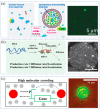Progress on Crowding Effect in Cell-like Structures
- PMID: 35736300
- PMCID: PMC9228500
- DOI: 10.3390/membranes12060593
Progress on Crowding Effect in Cell-like Structures
Abstract
Several biological macromolecules, such as proteins, nucleic acids, and polysaccharides, occupy about 30% of the space in cells, resulting in a crowded macromolecule environment. The crowding effect within cells exerts an impact on the functions of biological components, the assembly behavior of biomacromolecules, and the thermodynamics and kinetics of metabolic reactions. Cell-like structures provide confined and independent compartments for studying the working mechanisms of cells, which can be used to study the physiological functions arising from the crowding effect of macromolecules in cells. This article mainly summarizes the progress of research on the macromolecular crowding effects in cell-like structures. It includes the effects of this crowding on actin assembly behavior, tubulin aggregation behavior, and gene expression. The challenges and future trends in this field are presented at the end of the paper.
Keywords: actin assembly behavior; cell-like structures; crowding effect; gene expression; tubulin aggregation behavior.
Conflict of interest statement
The authors declare no conflict of interest.
Figures




Similar articles
-
Macromolecular crowding: obvious but underappreciated.Trends Biochem Sci. 2001 Oct;26(10):597-604. doi: 10.1016/s0968-0004(01)01938-7. Trends Biochem Sci. 2001. PMID: 11590012 Review.
-
Thermodynamics of Macromolecular Association in Heterogeneous Crowding Environments: Theoretical and Simulation Studies with a Simplified Model.J Phys Chem B. 2016 Nov 23;120(46):11856-11865. doi: 10.1021/acs.jpcb.6b06243. Epub 2016 Nov 15. J Phys Chem B. 2016. PMID: 27797534 Free PMC article.
-
Effects of macromolecular crowding on protein folding and aggregation studied by density functional theory: dynamics.Phys Rev E Stat Nonlin Soft Matter Phys. 2002 Nov;66(5 Pt 1):051902. doi: 10.1103/PhysRevE.66.051902. Epub 2002 Nov 7. Phys Rev E Stat Nonlin Soft Matter Phys. 2002. PMID: 12513518
-
Macromolecular crowding: Macromolecules friend or foe.Biochim Biophys Acta. 2015 Sep;1850(9):1822-31. doi: 10.1016/j.bbagen.2015.05.002. Epub 2015 May 8. Biochim Biophys Acta. 2015. PMID: 25960386 Review.
-
Macromolecular crowding for materials-directed controlled self-assembly.J Mater Chem B. 2018 Oct 28;6(40):6344-6359. doi: 10.1039/c8tb02201a. Epub 2018 Sep 26. J Mater Chem B. 2018. PMID: 32254643
Cited by
-
Genetically programmed synthetic cells for thermo-responsive protein synthesis and cargo release.Nat Chem Biol. 2024 Oct;20(10):1380-1386. doi: 10.1038/s41589-024-01673-7. Epub 2024 Jul 5. Nat Chem Biol. 2024. PMID: 38969863 Free PMC article.
-
Heavy Metals Toxicity: Mechanism, Health Effects, and Therapeutic Interventions.MedComm (2020). 2025 Aug 19;6(9):e70241. doi: 10.1002/mco2.70241. eCollection 2025 Sep. MedComm (2020). 2025. PMID: 40843132 Free PMC article. Review.
-
Carrageenan maintains the contractile phenotype of vascular smooth muscle cells by increasing macromolecular crowding in vitro.Eur J Med Res. 2024 Apr 22;29(1):249. doi: 10.1186/s40001-024-01843-2. Eur J Med Res. 2024. PMID: 38650027 Free PMC article.
-
The biophysics of water in cell biology: perspectives on a keystone for both marine sciences and cancer research.Front Cell Dev Biol. 2024 May 13;12:1403037. doi: 10.3389/fcell.2024.1403037. eCollection 2024. Front Cell Dev Biol. 2024. PMID: 38803391 Free PMC article.
-
High-viscosity driven modulation of biomechanical properties of human mesenchymal stem cells promotes osteogenic lineage.Mater Today Bio. 2024 Apr 16;26:101058. doi: 10.1016/j.mtbio.2024.101058. eCollection 2024 Jun. Mater Today Bio. 2024. PMID: 38681057 Free PMC article.
References
-
- Vibhute M.A., Schaap M.H., Maas R.J.M., Nelissen F.H.T., Spruijt E., Heus H.A., Hansen M.M.K., Huck W.T.S. Transcription and Translation in Cytomimetic Protocells Perform Most Efficiently at Distinct Macromolecular Crowding Conditions. ACS Synth. Biol. 2020;9:2797–2807. doi: 10.1021/acssynbio.0c00330. - DOI - PMC - PubMed
Publication types
Grants and funding
LinkOut - more resources
Full Text Sources

